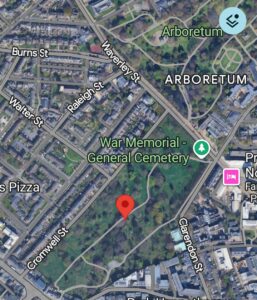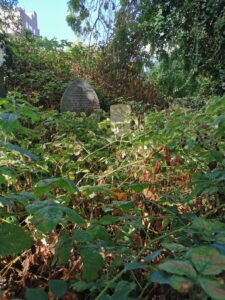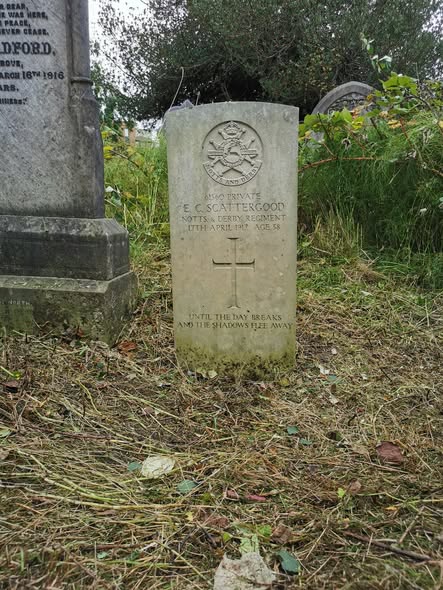We are pleased to promote the great work done by a group of volunteers in clearing and tidying the area around Commonwealth War Graves Commission graves at Nottingham General Cemetery.
The Facebook Group states its purpose as: To promote the many interesting private and military Memorials from Nottingham’s past and encourage new enthusiasts of Nottingham’s history.

Many of the 336 First World War burials in Nottingham General Cemetery were made from the Bagthorpe War Hospital and other war hospitals in the city.
More than 100 of these graves form a war plot, with the names of the dead inscribed on an adjoining Screen Wall.
There are also ten Second World War burials in the cemetery, and one Belgian grave.
Local Heroes
We have taken samples of their work that tells the story of families with a local connection to the Mapperley area.
Private 2961 Ernest Farnsworth
Private 2961 Ernest Farnsworth of the 2nd/7th Battalion, Sherwood Foresters (Notts and Derby Regiment) who was killed on 26th April 1916 in Dublin.
Ernest was born on 5th January 1891 at Nether Hallam, Sheffield. His family moved to Nottingham and Ernest was living with his family in Thorneywood and working as a Lace Draughtsman when he enlisted in October 1914.
In April 1916 he was stationed in Dublin with the Notts and Derby Regiment during the Irish Rebellion. On 26th April 1916, he was engaged in an attack on 25 Northumberland Road and Mount Street Bridge Dublin, when he was shot and killed. Thirty one Sherwood Foresters were killed during the 1916 Irish Rebellion.
Also killed was one of Ernest Farnsworth’s officers, 39 year old 2nd Lieutenant Montague Bernard Browne who was from Collingham, Nottinghamshire. Montague Browne was severely wounded during an attack on Clanwilliam House, and died from his wounds on 28th April 1916. Montague Browne and Ernest Farnsworth were buried together in a grave at the Deans Grange Cemetery in Dublin.
Repatriation
Montague Browne’s sister wrote to Ernest Farnsworth’s mother informing her of the burial, and offering to include Ernest on the memorial stone to Montague Browne, but Ernest’s elder brother William travelled to Dublin and had Ernest’s body exhumed. William Farnsworth was serving with 2nd Battalion, Warwickshire Regiment and William returned to Nottingham with the body of his brother, with Ernest being finally laid to rest at the Nottingham General Cemetery.
Sadly, William Farnsworth himself was killed near Ypres just over a year later, on 9th October 1917. He is commemorated at the Tyne Cot Memorial.


Private 61560 Ernest Charles Scattergood
Private 61560 Ernest Charles Scattergood, 9th Battalion Sherwood Foresters (Notts and Derby Regiment) died on 17th April 1917 aged 38.
Ernest was born in 1879 at Union Cottages, St Anns, Nottingham. His father Charles was a stationer and his mother Emma was a cigar maker. Prior to enlisting, Ernest was a Warphand Lace Maker and living with his mother at Gladstone Street, Basford, Nottingham.
Ernest enlisted with the 9th Battalion Sherwood Foresters, and was at the Front in January 1916. Ernest appears to have been taken ill whilst at the Somme, and was repatriated back to England where he was admitted to the War Hospital, Upton, Northamptonshire. The Upton War Hospital, also known as the St. Crispin Asylum was requisitioned to treat wounded soldiers and those affected by the psychological trauma of war.

Ernest died of “Nephritis” more commonly known as kidney failure.
He was buried at Nottingham General Cemetery on 20th April 1917.
Photo taken in 2025 after the area around the grave was cleared.
Why are our cemeteries not maintained anymore?
Peter Russell, an expert historian on Nottingham’s cemeteries explains.
The General Cemetery was uneconomic and went bankrupt after WWII. It was sold to the City for 5 pence (1 shilling) in the 1960s but has become a huge white elephant because there are liabilities but no income. Families of the buried have long ceased offering to pay for the upkeep of the graves, and many moved away from Nottingham altogether. That leaves the council with a bill it only wants to reduce as much as possible.
There is also a more modern view to allow re-wilding of some open spaces. There are arguments for and against the maintenance of these sites. There stories though are not forgotten. For more on the work of the CWGC and the General Cemetery, go to https://www.cwgc.org/visit-us/find-cemeteries-memorials/cemetery-details/2069763/nottingham-general-cemetery/

